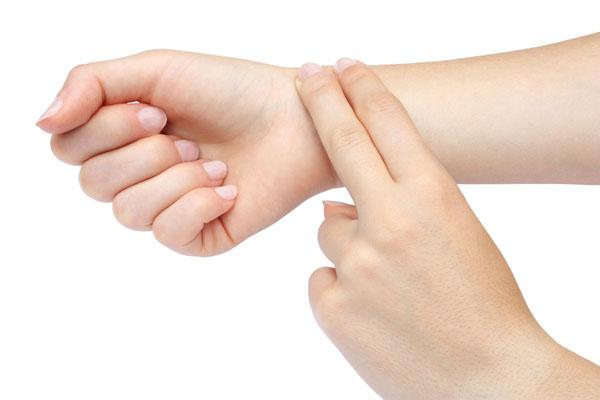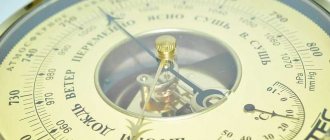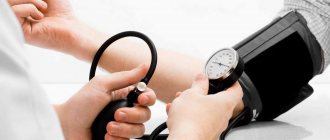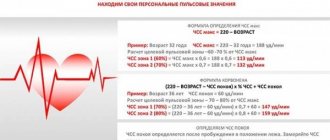In this article we will discuss how to measure blood pressure without a tonometer? The easiest way to measure blood pressure outside the home is in pharmacies; many pharmacies have this option. But if it is not possible to use this method, you can resort to one of three methods for determining pressure without a tonometer:
- Based on the patient’s well-being, more accurately based on symptoms and signs that may indicate an increase or decrease in blood pressure.
- By the pulse on your hand.
- Using a pendulum made of a ruler and a ring.
Is it possible?
The rhythmic contractions of the heart can tell a lot about our body and blood pressure in particular. It is important to take into account that they depend on many factors - time of year and day, mood, age. The normal heart rate differs between people of retirement age and teenagers, between obese and thin people, in the morning and in the evening.
The measurement results can be distorted by the presence of diseases such as atherosclerosis, age-related changes in blood vessels, diseases of the endocrine system, heart failure, etc. Some of these pathologies will indicate low blood pressure, and some, on the contrary, high blood pressure. Accordingly, the data obtained during the measurement process will not be reliable.
Answering the question whether it is possible to obtain accurate numbers by measuring the pulse on the hand, it must be said that this is impossible. All information obtained in the process is indirect. Moreover, in emergency situations, when there is no time to measure the pulse with a tonometer, such diagnostic tactics provide sufficient information about the state of a person’s health.
Methods of measurement without a tonometer
To measure blood pressure without a machine, it is important to calm down and take a comfortable position. If there are jewelry, bracelets or watches, they must be removed. It is also important to avoid physical activity and not eat for half an hour. Next, perform the following manipulations:
- The right hand is placed on the left wrist and the point where the pulsation is best heard is felt.
- Do not move or speak; the hand used to measure the pulse should be at the level of the heart.
- The time is noted and the heartbeats are counted for 30 seconds. We multiply this number by 2.
- Next, the results are compared.
If the pulse is less than 60 beats, then the blood pressure is low. Numbers 60-80 indicate normal blood pressure.
If your heart rate is more than 90 times per minute, you should immediately call an ambulance.
Another interesting method for diagnosing high and low blood pressure is pressing on the wrist. In hypertensive patients, when pressing on the hand, the pulsation is felt more strongly. With hypotension, squeezing the wrist slows the pulse and makes it feel weaker.
You can check your blood pressure at home using a thread and a ruler. This is a rather unusual method, but the results are correct, albeit with errors of several units.
You need to take a 20 cm long ruler, a thread and a ring. The ruler is placed so that mark 0 is on the wrist, and the end is on the elbow. The ring is put on a thread and, holding the resulting pendulum by the tip, it is brought to the ruler. Move the thread with a ring from 0 to 20 slowly, without sudden movements. The closer the ring is to the ruler, the more accurate the results.
At a certain point, you will notice that the pendulum begins to move to the sides. This figure is multiplied by 10. When measured using this method, the first digit will indicate the diastolic pressure. To obtain information about the systolic indicator, the pendulum continues to be moved along the ruler. There is no need to start from 0. The second number at which the ring begins to swing or rotate will be the top pressure. It should also be multiplied by 10.
What conditions must be observed?
If you have reason to believe that your blood pressure has suddenly increased or decreased because you feel noticeably worse, rest for a while. 5 minutes will be enough. Sit down, relax, think about something pleasant. It would be a good idea to visit the toilet.
p, blockquote 10,1,0,0,0 —>
If on this day there was no consumption of tonic drinks, such as coffee, strong tea, carbonated drinks (many of them contain caffeine), the readings will be more accurate.
p, blockquote 11,0,0,0,0 —>
When measuring your blood pressure, sit comfortably, don't cross your legs, don't talk, and breathe freely. This way you will get more reliable indicators. Having fulfilled all the specified conditions and selected your method, you can safely begin research.
p, blockquote 12,0,0,0,0 —>
p, blockquote 13,0,0,0,0 —>
Possible mistakes
Many people, when trying to measure blood pressure using their pulse rate, make mistakes and, as a result, receive false information about the state of their health. During diagnosis, it is necessary to take into account not only the number of heartbeats, but also their rhythm.
Sometimes it is arrhythmias that provoke pressure surges and in this case drug treatment is required. As soon as the heart muscle normalizes its rhythm, the unpleasant symptoms will disappear.
It is also a common mistake to measure your heart rate only from your wrist. The heartbeat can also be clearly heard in other areas - under the knee joint, on the temples, on the neck. It is important to compare the indicators obtained at different points and only then draw conclusions. Strong pulsation on one arm and weak pulsation on the other cannot be considered normal. Only a doctor can accurately calculate blood pressure using the pulse.
The inability to correctly interpret the data received or measure the pulse will lead you to many negative thoughts, which, as a rule, are one of the main causes of pressure surges.
Characteristic symptoms
In addition to calculating the pulse, you can determine high or low blood pressure by observing a person’s well-being. There are a number of symptoms that indicate hypertension or hypotension. Signs of high blood pressure include:
- significant redness of the face;
- dizziness;
- pain in the heart area;
- pulsation in temples;
- feeling of lack of air.
With low pressure, hands tremble, drowsiness, lethargy, pain in the back of the head appear, dizziness, nausea and vomiting may occur. All these symptoms must be taken into account when measuring blood pressure without a tonometer. They may appear separately or all together. At an early stage, hypotension and hypertension always look like ordinary overwork.
It is important to note that such signs of deterioration in health may indicate not only surges in blood pressure, but also the development of serious diseases of the cardiovascular system, so do not hesitate to go to the doctor. By postponing the visit, you deliberately provoke the progression of the pathology.
Is it possible to measure blood pressure without a tonometer? This question interests many, since a deterioration in a person’s well-being can occur suddenly, in conditions where there are no medical devices at hand. Such methods exist. Let's look at them and talk about how accurate they are and whether the results obtained can be trusted.
Blood pressure (BP) is the force with which blood acts on the walls of the arteries. This value is not constant. For example, during physical activity, muscles experience increased demands for oxygen and nutrients. As a result, the heart contracts with greater force, and blood pressure increases by 10-20 mm Hg. Art. When resting, the body's need for oxygen decreases, and a person's blood pressure returns to normal. Therefore, blood pressure should be measured by any method only at rest.
Normal blood pressure for an adult is in the range of 91–139/61–89 mmHg. Art. In this case, the absolute norm is 120/80 mmHg. Art.
Symptoms of high and low blood pressure
If signs of hypertension appear, it is very important to notify your doctor in a timely manner. In normal condition, the pressure should be 120/80 mmHg. Art. Deviations of 10-15 points in one direction or another are acceptable - this depends on the individual characteristics of the human body. Blood pressure is considered elevated at a level of 140/90 mm Hg. Art.
A short-term increase in the parameter may be associated with physical activity, consumption of caffeine, salt, fatty or spicy foods. It can also be caused by a stressful situation. The listed factors provoke an increase in the parameter by 20-30 minutes.
If the symptoms of arterial hypertension are constantly present, the cause is various pathologies. These include diseases of the kidneys, heart, thyroid gland, and atherosclerosis. The problem often occurs in women during pregnancy, menopause, and adolescence.
How can you determine blood pressure without a tonometer based on symptoms? The following symptoms indicate high blood pressure:
- nausea and vomiting;
- headache – most often localized in the forehead and temples;
- heartache;
- increased sweating;
- facial redness;
- tachycardia;
- temporary loss of clarity of vision;
- swelling;
- sleep disorders;
- dyspnea;

- increased nervousness.
There are also other symptoms associated with high blood pressure. They may differ from person to person. Without a special device, an increase in pressure can be detected by the heartbeat in the temples.
Of course, it is much easier to check your blood pressure using a tonometer, but it is not always available. If the indicator rises very strongly, you should call an ambulance. At home, you should take medications that normalize blood pressure and pulse.
Important: Hypertension is a very dangerous condition that can lead to serious complications. These include myocardial infarction, kidney damage, and progression of atherosclerosis.
Low blood pressure also poses a health risk. Hypotonic patients often experience ischemic stroke. They may also faint and lose feeling in their limbs. In old age, such people often suffer from dementia, which is caused by insufficiency of cerebral circulation.
Arterial hypotension may be associated with pathologies of the digestive system, congenital heart disease, and vitamin deficiency. Infectious pathologies also often lead to the problem.
In addition, there is adaptive hypotension. In this case, the decrease in the indicator is due to the influence of external factors. These include stressful situations, low air temperature, decreased blood volume, and staying in a stuffy room.
This form of disorder is considered a protective reaction of the body. After eliminating the provoking factor, the indicators return to normal.
Low blood pressure is accompanied by the following symptoms:
- increased drowsiness;
- feeling of weakness in the muscles;
- feeling of lack of air;

- headache in the occipital region.
A decrease in pressure leads to deterioration in performance. Some people develop a fear of bright lights and loud sounds, and their pupils become constricted.
To measure blood pressure without a tonometer, you should use a pendulum. However, determining the heart rate will not help to recognize the exact level of blood pressure.
How to check blood pressure without a tonometer using your pulse
Another way to indirectly assess blood pressure levels without any device is to analyze the frequency and strength of the pulse. The table shows the main characteristics of the pulse wave that you need to pay attention to.
Pulse rate (number of waves per minute)
The pulse may be normal (60-90 beats per minute) or low (less than 60 beats per minute). Increased heart rate with low blood pressure is usually observed only against the background of massive blood loss
Tachycardia usually develops (pulse rate reaches 90 beats per minute or more). A normal pulse rate (60-90 beats per minute) is much less common. If a patient develops bradycardia due to hypertension, in most cases this indicates an acute cerebrovascular accident (stroke)
Even light pressure with your fingers on the skin above the artery leads to the disappearance of the pulse wave
To stop the pulse wave, apply forceful pressure to the skin over the artery
Not tense, soft
Thus, analysis of pulse characteristics makes it possible to distinguish high blood pressure from low blood pressure.
How to determine pressure without a tonometer using a pendulum
How to measure blood pressure without a tonometer at home? This can be done using a ruler and a simple pendulum. There have been no clinical studies of this method, and it rather relates to bioenergetics and extrasensory perception than to medical science, therefore the results obtained cannot be called reliable.
Blood pressure should be measured by any method only at rest.
To measure pressure with a ruler and pendulum you need:
- Make a pendulum. To do this, take a thin cord (thick thread) 20-25 cm long, tie a small nut or ring to one end, leaving the other end free.
- Place the forearm of the person being examined on a flat horizontal surface, the palmar surface of the hand should be facing upward.
- Place a regular school ruler on your forearm so that its base lies on the elbow area.
- Take the pendulum in your hands and lower the ring above the zero division of the scale. It should be located as close to the ruler as possible, but not touch it.
- Start slowly moving your pendulum along the ruler towards your hand.
- Note at what segment of the scale the movements of the pendulum from chaotic will become of the same type, in the direction transverse to the surface of the ruler. Multiply the marked figure by 10. The result obtained will correspond to the systolic (upper) pressure.
- Turn the ruler over so that its base now rests in the crease between your hand and forearm.
- The pendulum should now be slowly moved from the hand towards the elbow joint.
- Also mark the point on the scale where the movements of the pendulum became clearly transverse. Multiply the resulting figure by 10. The result obtained corresponds to the lower (diastolic) pressure.
- Repeat the measurement procedure again.
As you can see, pressure can be measured using various available methods. However, the results obtained are very approximate, and even unreliable. Therefore, if a person suffers from hypertension or hypotension and needs regular blood pressure monitoring, it is necessary to purchase a tonometer at the pharmacy - a device for measuring blood pressure using the Korotkov method.
Deviation of blood pressure from the norm by more than 10-15 mm Hg. Art. leads to a deterioration in general health.
How to measure blood pressure without a tonometer
The degree of correctness of blood pressure can be easily calculated from the pulse, since their indicators are very closely interrelated, that is, by the nature of the state of one of them, deviations in the second can be determined.
However, even in this case, it will not be possible to find out the maximum accuracy of blood pressure, but it is quite possible to establish approximate parameters, which can also be important. How to measure blood pressure without a tonometer using the pulse, and how accurate will the results of such readings be? If you don’t know what the beat frequency of a normal pulse is, then it is set based on the person’s age, so for people of different age groups the normal indicator is considered to be:
- 20-45 years – 70 beats/min.
- 50-55 years old – 74 beats/min.
- 60 years and older – 79 beats/min.
So, how can you determine your blood pressure using your pulse? The proposed tablet indicates specific pulse deviations, by which you can independently find out what exactly is happening in the vessels.
| Features of pulse condition | Low blood pressure | High blood pressure |
| Beats per minute | Infrequent pulse - 50-60 beats. The correct rhythm is 60-90, a significantly reduced rhythm is observed with excessive blood loss. | Increased rhythm - 90 beats. The normal rhythm is 60-90 beats, and a slower pulsation indicates a cerebral hemorrhage. |
| Pulse strength | It disappears at the moment of slight pressure on the artery. | You can feel it even with intense pressure. |
| Pulse intensity | Soft, tension is very weak or absent. | Stiff and overly tense. |
You can study the pulse rhythm in any arteries that are more convenient for palpation, for example, in the following places of the body:
- Inner arm bend area (elbow).
- Femoral artery (groin area).
- Armpit area.
- Popliteal area of the leg.
- Dorsal artery of the foot.
- Vessels located on the front side of the neck slightly below the angle of the jaw.
- The outer side of the flexor area of the lower 1/3 of the forearm near the outer edge next to the wrist, the so-called radial artery.
Finding out your blood pressure without a tonometer by setting the number of pulse beats is quite simple. To do this, you will need a stopwatch; a watch with a second function will work instead. Before you start measuring, you need to pay attention to the following tips:
- Before measuring, try to relax as much as possible.
- An hour before the procedure, do not drink drinks such as alcohol, tea or coffee. They can provoke an increase or decrease in blood pressure.
- Be sure to go to the toilet.
- Do not smoke in the last hours before the measurement - nicotine can lower or increase blood pressure.
- It is necessary to take the most comfortable position.
- Remove rings, bracelets and similar items from your hands that may interfere with normal blood flow and pulse function.
- During the procedure itself, it is forbidden to move or speak.
- With the middle and index finger of your right hand, lightly touch the wrist of your left hand and find the location of the pulse.
- To check its rhythm, you need to count the number of beats in 30 seconds, and then multiply this number by 2. The resulting number is the blood pressure level.
Normal rhythm is 60-80 beats/min, less than 60 – low blood pressure, more than 80 – high blood pressure. Be sure to consider your age category. To more accurately determine blood pressure, it is necessary to measure the pulse in both upper extremities. If there is a significant difference in pulse beats on the right and left hands, this indicates the development of serious cardiac pathologies.
There is another effective method for determining pressure without a tonometer using ordinary objects. You can measure blood pressure and obtain numbers without a tonometer using a ruler and a ring. However, it is worth keeping in mind that official medicine considers this method of checking pressure to be quite dubious, since no specific studies have been carried out on it, so there is no information about its reliability.
On the other hand, there are enough facts and reviews from people who claim that this method really works. Be that as it may, in some situations this option for determining blood pressure can be useful for patients with hypertension or hypotension. So, how to measure pressure with a ruler and ring if there is no special apparatus?
The technical side of this process is completely simple, the main thing is to carefully follow the sequence. In order to measure blood pressure at home, you need to make a pendulum, which will require:
- A strong thread or thin cord 20 cm long.
- A ring, either made of precious or other metal, or simply a piece of wire bent into a ring, is suitable as a load for the thread. A nut, pin, paper clip or needle will also work.
- A ruler (plastic, wood, metal) 20-30 cm long, but a measuring tape will also work instead.
When all the necessary things are prepared, you can begin the procedure for measuring blood pressure:
- Attach a weight (ring or needle) to one end of the thread, and its other end should be free.
- Now you need to sit down or sit down or lay down the person whose blood pressure you will measure.
- Place the forearm on a fairly hard and stationary surface, so that its flexion side is directed upward. Blood pressure should be measured on the left arm, but is also allowed on the right.
- The ruler is positioned so that the beginning of its report is located strictly on the elbow bend. For greater convenience, you can place marks on the forearm at a distance of 1-2 cm.
- Now you need to take the free end of the thread and install the attached weight directly above the ulnar cavity of the forearm at the very beginning of the ruler report, so that the pendulum does not contact the skin, but is as close to it as possible (1-2 cm), while still being able to move freely.
- The pendulum itself needs to be held in a motionless position for several seconds, then slowly begin to move it over the surface of the forearm towards the hand.
- As the pendulum moves, it will perform random swings, but at some point the nature of its movement changes to more distinct oscillations in the transverse directions from the forearm and the ruler.
- This place needs to be marked with a dot, and see at what distance such swaying occurred. The resulting number must be multiplied by 10, this result will correspond to systolic blood pressure.
- Next, the ruler, with the beginning of its report, is moved to the first transverse skin fold, which is located just above the hand.
- Place the thread with the pendulum above the zero point of the ruler, slowly moving the load over its surface towards the elbow dimple.
- When the pendulum begins to exhibit pronounced movements in the transverse direction, these centimeters should be noted and again increased by 10. Thus, the lower state of pressure is determined.
- This completes the blood pressure check.
It is preferable to check blood pressure using the pendulum method on both arms, which allows you to obtain more accurate information about pressure.
Pulse and pressure are two main markers of the functioning of the vascular system. Their indicators correlate with each other, so by measuring the pulse, one can assume (but not say) in which direction the pressure level has changed.
Before you figure out how to find out the pressure without a tonometer by pulse, you need to understand how to correctly calculate the number of heartbeats per minute:
- the pose should be comfortable and relaxed;
- the pads of the fingers should be pressed to the anterolateral surface of the neck, the place above the wrist, the inside of the elbow;
- Having determined the frequency of impacts in 15 seconds, the indicator should be multiplied by 4.
The procedure for measuring the pulse on the radial artery.
In a healthy person, the pulse is in the range of 60-80 beats per minute. When blood pressure changes upward, the pulse may remain normal or increase slightly. With hypotension, an increase in pulse rate is observed in all cases. This is a compensatory reaction aimed at maintaining adequate blood supply to tissues.
The effectiveness of the method is also not high: firstly, with high blood pressure, the heartbeat may be within normal limits. Secondly, there are other factors that influence the pulse against the background of pressure: age, lifestyle and a person’s concern for health. Important! Children and adolescents have their own age-specific norms for blood pressure and heart rate.
Some people can check the pressure level qualitatively (high, normal, low) without wasting time and effort. But quantitatively (obtaining a specific numerical indicator) you can determine blood pressure without a tonometer only by one method - using a pendulum (a needle, a gold ring and a ruler).
To measure you will need:
- ruler;
- thread about 20 cm;
- pendulum (you can use a ring, nut, needle).
The pendulum is fixed at the end of the thread, the ruler is applied to the hand from the wrist to the elbow so that the zero mark coincides with the place where the pulse is felt (at a point above the hand).
Illustration of measuring blood pressure using a thread and a gold ring.
You can measure pressure with a ruler using the following algorithm:
- holding the free edge of the thread with your hand, the pendulum should be positioned above mark 0 on the ruler, at a height of up to 2 cm;
- after the pendulum stops swinging, it is necessary to slowly move it up the ruler;
- when the thread begins to swing, you need to remember the indicator on the ruler near which this happened;
- without interrupting the movement, you should move the pendulum further along the ruler;
- when repeating the oscillatory movement, you need to remember the number on the ruler scale again.
The result is 2 numbers that should be converted into pressure indicators. To do this, you simply need to multiply them by 10. The first number will indicate the lower (diastolic) pressure, the second - the upper (systolic). For example, if the pendulum pointed to the numbers 6 and 11, then the person’s pressure will be 110/60 mmHg.
A significant disadvantage of this method is its unscientific nature. There is not a single reliable confirmation that the technique actually works. This method of determining pressure without a tonometer is much closer to the field of extrasensory perception than to medicine.
What pressure is considered normal?
Normal blood pressure for an adult is in the range of 91–139/61–89 mmHg. Art. In this case, the absolute norm is 120/80 mmHg. Art.
However, it should be understood that normal blood pressure is an individual indicator for each person, the main thing is that it is within the above limits. For example, a blood pressure of 120/80 is normal for one person, high for another, and low for a third.
Low pressure (below 90/60 mm Hg) is called hypotension, and high pressure (above 140/90 mm Hg) is called hypertension.
We offer you to watch a video on the topic of the article.
Article publication date: 08/07/2018
Article updated date: 11/16/2018
Author: Yulia Dmitrieva (Sych) – practicing cardiologist
In this article we will figure out how to measure blood pressure without a tonometer, how accurate such measurements will be, and also learn the characteristic signs of an increase and decrease in blood pressure.
There are three ways to determine blood pressure without instruments:
- analytics based on the patient’s symptoms and complaints;
- using pulse measurement;
- using a ruler and a pendulum.
It is important to understand that the symptoms and pulse can only determine the very fact of whether the patient has high or low blood pressure. Specific numbers can only be obtained using a ruler and a pendulum.
Indicator values
Each person has individual norm indicators, so it is necessary to know in advance what their values are and adhere to this norm.
To recognize high or low blood pressure, consider the following:
- age;
- person's weight;
- health status for this indicator.
A common indicator is 120/8: that is, 120 is systolic and 80 is diastolic pressure.

You can use the ready-made formula: B x 0.6 + 102 is systolic, B x 0.4 + 63 is diastolic. B is the person's full age.
Although this formula is not considered accurate, since each person is special.
We focus on symptoms
High and low blood pressure can be identified by characteristic symptoms.
To begin with, it is important to make sure that you understand that blood pressure level consists of two indicators - lower and upper.
Average table:
Symptoms that your blood pressure has risen:
- headaches in the temple area;
- dizziness attack;
- painful sensations in the heart;
- nausea, urge to vomit;
- nervousness, sleep disorders;
- sudden rush of blood to the face;
- a blood artery becomes noticeable in the neck;
- increased sweating.
- pulsation of the heartbeat in the head, in the temporal zone.
If a person experiences several symptoms at the same time and is concerned about a sharp deterioration in their health, they should immediately call an ambulance.
The above signs do not confirm hypertension, but only indicate a short-term increase in blood pressure, which can be caused, among other things, by a stressful situation, drinking large amounts of coffee, physical labor, or heavy food.
The following signs indicate low blood pressure:
- the appearance of headaches in the occipital region;
- lethargy, decreased performance;
- muscle relaxation;
- drowsiness;
- pale skin, weakened heartbeat;
- increased breathing, a feeling of being unable to breathe deeply.
A short-term decrease can also be observed against the background of extreme heat or low air temperature, or nervous shock.
conclusions
It is presented in detail how to independently distinguish high blood pressure from low blood pressure, and what to do if the condition worsens.
Constant problems with indicators often cause hormonal imbalance, a noticeable general deterioration in health, and the development of brain disease.
Therefore, it is important to be attentive to your well-being and provide first aid if necessary.
People with hypertension are often bothered by headaches (while hypotension is manifested in most cases by weakness and unreasonable sweating).
Knowing exactly how to determine low pressure from high pressure (as determined by a tonometer and accompanying symptoms), the development of the disease can be stopped and its transition to a chronic form can be prevented.
We estimate the blood pressure level by pulse
If you don't have a special device, you can measure your blood pressure using your pulse.
This method is easy and simple; the most important thing is to correctly recognize your pulse rate.
The procedure takes place in several stages:
- You need to take a comfortable position - sit down or, if possible, lie down, try to relax.
- To take the measurement you will need a watch or mobile phone with a stopwatch.
- Clothes should be loosened and sleeves rolled up.
- After this, you need to feel the pulsation point on your right hand with your left hand.
- Carefully count your pulse rate for 60 seconds.
The resulting numbers will allow you to understand whether your blood pressure is high or low. When pressure decreases, the pulse rate may increase, and when pressure increases, it may decrease.
However, it is important to understand that heart rate also directly depends on the individual characteristics of the body. In normal condition, it varies between 60-90 beats per minute. For the fair sex, this figure is slightly lower and ranges from 60 to 100 beats per minute.
Click on the picture to enlarge
In addition, in some cases, it may be that other factors influence the pulse rate - gender, age, elevated body temperature, adverse weather conditions, physical fatigue, mental stress, and taking certain medications. A woman may experience an increased heart rate during pregnancy.
It is for this reason that measurement using pulse cannot be considered 100% correct; you can only rely on it.
What influences the results?
The appearance of high or low blood pressure requires careful diagnosis. Many factors influence changes in indicators:
- Emotional condition. In stressful situations, blood pressure often increases.

- Use of medications. Many medications provoke hypertension.
- Menopause. During this period, many women experience a change in the balance of hormones in the body, which also affects blood pressure levels.
- Overwork. People who cannot establish a normal work and rest routine often experience hypertension.
- Excess weight. Excess body weight leads to increased stress on the cardiovascular system. As a result, such people often face high blood pressure.
- Bad habits. Smoking and excessive drinking can also cause problems.
Measuring blood pressure is a very important procedure that helps you keep your condition under control and take medications in a timely manner. If you don’t have a tonometer at hand, you should use available home methods to assess this parameter.
Did you like the article? Save it!
Still have questions? Ask them in the comments! Cardiologist Mariam Harutyunyan will answer them.
Ivan Grekhov
Graduated from the Ural State Medical University with a degree in General Medicine. General practitioner
Measurements using a ruler and pendulum
You can also easily find out your blood pressure level at home or anywhere else using a regular ruler and pendulum.
A ring, an ordinary sewing needle, a nut or a paper clip are perfect for the pendulum itself. The ruler can be anything - metal, wood or plastic.
The measurement algorithm looks like this:
- You need to take a thread 15-20 cm long, thread a paper clip, needle or ring into it, and tie a knot at a distance of about 7 cm. The ruler is placed directly on the hand of the person whose pressure will be measured, preferably the left one. It should lie in such a way that the scale with divisions starts from the elbow bend. During the measurement process, the sleeve does not need to be lifted; this does not in any way affect the information content of the procedure.
- After this, you need to take the thread with the pendulum in your right hand, bring it to the ruler in the area of the elbow joint and slowly move it to the person’s wrist area. At this moment you should be extremely careful and collected, not talk, not move or be distracted.
- When the thread is passed along a certain section of the ruler, the pendulum begins to swing in different directions. This means that this mark on the ruler indicates the upper blood pressure indicator. This number must be multiplied by 10. For example, if the pendulum determined the number 15, then the blood pressure increased to a level of 150 mm. rt. Art.
- Next, you need to measure your lower blood pressure in the same way. For this purpose, the thread must be moved to the wrist area and begin to move it from this side. The mark on the scale at which the pendulum begins to swing indicates the lower blood pressure. It is also multiplied by 10.
This method of measuring blood pressure at home without a special device is quite easy and effective.
We invite you to watch a video about how to use a pendulum correctly and avoid mistakes:
However, it should be understood that the reliability of the data obtained using this method has not been confirmed by official medicine. Although the Internet is full of reviews that this is a truly accurate and effective method. Here everyone must decide for themselves, in any case, no one is stopping you from using the ruler method, and then immediately measuring blood pressure using a regular tonometer, comparing the numbers obtained and drawing conclusions.
Based on the above methods, it is impossible to diagnose hypertension or hypotension. In order to identify these diseases, you need to check your blood pressure several times with a tonometer or consult a doctor.
Is it possible to check blood pressure using a smartphone?
Despite the fact that Google Play and the App Store are full of applications promising similar functionality, measuring your blood pressure using a mobile phone is simply technically impossible! It initially does not have a filling that would allow this to be done, and no application will correct this situation.
In most cases, under the guise of such programs there are simply diaries for taking measurements of your blood pressure, where you can write it down. And what’s even worse is that they often turn out to be fraudulent programs. The fact is that to simplify payments in many smartphones, you just need to put your finger on the screen or button for the money to be debited.
Dishonest developers take advantage of this and ask you to put your finger on it, supposedly to measure your pulse and blood pressure, but in fact at this moment you confirm your consent to transfer money to them. We kindly ask you not to download or use such utilities under any circumstances.
The only smart gadgets that can really help you find out your blood pressure are special fitness bracelets, which, by the way, usually come with accompanying programs for your phone. But you must be aware that the data obtained in this way is very likely to be unreliable. The tonometer is simply irreplaceable for now.
Author of the article: Nivelichuk Taras, head of the department of anesthesiology and intensive care, work experience 8 years. Higher education in the specialty “General Medicine”.
From this article you will learn: how to measure pressure without a tonometer, whether you can trust the results of such measurements, read the detailed instructions for the main methods of determination.
Blood pressure measurements were carried out even before the invention of the tonometer. People have come up with simple ways to determine the degree of vascular tension in the body. Their results indirectly, but quite accurately reflected changes in those indicators, the significance of which was learned only after the discovery of tonometry.
Despite the existence of modern methods that make it possible to measure blood pressure with high accuracy, interest in primary non-hardware methods does not disappear.
The main ways to find out the pressure level are given in the table, and they are described in detail in the article.
How to determine blood pressure based on complaints and symptoms
The most basic tonometry using a qualitative method is the characteristics of existing complaints. The desire to measure blood pressure (BP) mainly arises in people who have some abnormalities in the body that cannot be associated with anything (unexplained weakness, headache, nausea, etc.). Such a desire rarely occurs in healthy people. Since in 70–85% of complaints and symptoms a change in pressure is hidden, by their nature it is possible to indirectly (preliminarily) determine whether it is increased or decreased.
The table describes typical symptoms of hypotension and hypertension:
There are also additional signs that can be observed in both hypertension and hypotension. They can be misleading and cannot be a criterion even for an approximate determination of pressure:
- Pressing pain in the chest.
- Shortness of breath or feeling of shortness of breath.
- Darkening in the eyes.
- Loss of consciousness.
Even an experienced specialist in symptoms and complaints will only be able to correctly judge the level of blood pressure in 60–70% of cases - only to determine whether it is increased or decreased.
Determination of pressure by pulse
The state of the circulatory system is reflected by two main indicators: pulse and blood pressure (BP). They are interconnected, which means that by the characteristics of one of them it is possible to determine the characteristics of the second. Pulse characteristics are more informative in this regard.
It is impossible to accurately determine the level of pressure from the pulse, but everyone can judge this indirectly (approximately). The table describes the main characteristics of the pulse that you need to pay attention to.
The pulse can be assessed on any arteries that are more convenient to feel with your fingers. It can be:
- vessels on the anterolateral surface of the neck immediately below the angle of the jaw;
- the outer edge of the flexor surface of the lower third of the forearm is closer to the outer edge just above the wrist (radial artery);
- the inner part of the elbow;
- groin areas (femoral artery).
If you don’t know what a normal pulse should be, compare its character in any healthy person or in yourself with the pulse of a patient!
Diagnostics
If your blood pressure is low, you should contact a cardiologist. And to make an accurate diagnosis of hypotension, blood pressure monitoring is necessary. That is, a woman must measure her blood pressure several times a day for a certain period of time. The attending physician talks about this in detail. Further additional examination methods are prescribed:
- Hardware diagnostic techniques: electrocardiography, echocardiography, ultrasound. The causes and associated diseases are identified.
- Electroencephalography studies the signals that come from the brain. This requires registration of indicators. This technique also reveals changes in the visual organs.
- To identify the orthostatic form of hypotension, title testing is performed using a special device.
- A test is carried out during physical activity - the pulse is measured and the reactions of the circulatory system are studied.
- It is necessary to donate blood for general and biochemical analysis.
If you do not know what pressure monitoring is, watch the video presented, which uses modern monitoring methods.
Quantitative pressure measurement using a pendulum and ruler
The only way to measure pressure numbers without a tonometer is to use a pendulum with a ruler. The effectiveness of this method leaves doubts, since there is not a single official study that would confidently confirm its reliability. This means that there is no scientific basis for the technique. It rather belongs to the field of extrasensory perception and bioenergy.
However, its great popularity suggests the opposite - a lot of amateur evidence has been created: supporting videos and text facts. Therefore, to believe or not to believe pressure indicators, if they are measured using a pendulum and a ruler, everyone must decide for themselves.










